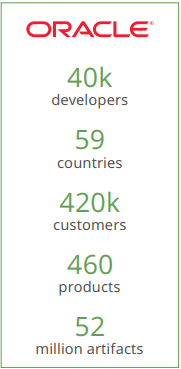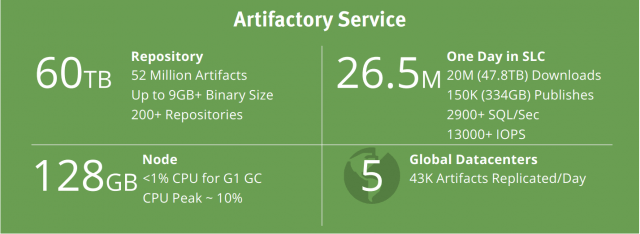Use Case – Managing Artifacts at Scale
Why Oracle Chose JFrog Artifactory as its Universal Artifact Repository Manager
Loreli Cadapan
Director, Development Operations at Oracle
Oracle’s Scale
Technology giant, Oracle, is one of the world’s largest and most well-known IT companies. Businesses all over the world are powered by Oracle’s database management systems, middleware, cloud solutions, and IT infrastructure. To deliver to their 420,000 customers worldwide, they employ 40,000 staff on the development side to produce 460 products. These workers are spread out over 59 countries – from Albania to Algeria, from Venezuela to Vietnam.
Working on this massive scale produces an enormous number of artifacts that need to be managed efficiently.
Oracle’s operations included millions of artifacts stored in terabytes of data spread out over several global data centers and supporting tens of millions of hits per day. To function on this immense scale, Oracle needed a solution to manage this ever- increasing number of artifacts.
Choosing JFrog Artifactory
In early 2012, Oracle conducted a stringent evaluation process, and eventually selected Artifactory over its competitors for several reasons. The product was able to support the massive scale required by Oracle while maintaining performance and reliable access to artifacts.
The original rollout started with a small group of project teams, in just one line of business – middleware. Meeting with a great deal of success, this piqued the interest of other product teams who were looking for a repository manager that would open up the black boxes that were hiding details about artifacts in their system. Oracle developed a very scheduled onboarding process while keeping everything open and allowing anybody to query the system. Ms. Cadapan said, “This is a kind of multi-master environment in which everybody is an admin. While Artifactory comes with the ability to audit activity and detect if mistakes are made, we found that this hasn’t been necessary, and people just manage to do the right thing”.
Artifactory provided the necessary momentum by making it possible to query the data to see what was changing. “This empowered Oracle to build a whole eventing model around Artifactory allowing developers to know what their destiny looks like. Once you do this, wonderful things happen. Cadapan added. “Giving people a platform allows them to create their own complex pipeline rather than having it created and managed by a central team. This means that the ownership of releases lies within the teams themselves, rather than in central release teams as is prone to happen in large companies. This way, The central teams are free to concentrate on more general metrics, such as consumability. It’s all a question of transparency.”
Cadapan concluded.
Oracle uses Artifactory on a very large scale; it’s a system that gets a great deal of use – 25.7 million hits per day. Over time, much of the company’s development ecosystem formed around Artifactory, which effectively became a development hub. This led Oracle to reexamine its entire set of development processes. In other words, not only did Oracle bring in Artifactory as its binary repository, the company looked at its entire development ecosystem and optimized everything around Artifactory across the board. As Ms. Cadapan puts it, “It gave us the opportunity to say, nope, we won’t follow the old processes; we’ll bring it over to the new way of doing things”.
The People that Stand Behind the Product
Beyond product behavior and features, the success of Artifactory at Oracle is largely due to the people at JFrog. As Artifactory permeated through the different organizations at Oracle, JFrog provided extremely responsive and capable support and was very attentive to the company’s needs in defining Artifactory’s roadmap. Oracle understood that the success of a product largely depends on the company and the people that stand behind it.
Summary
Artifactory was originally brought into Oracle for the Middleware division but quickly gained attention from other project managers. It gave developers insights and transparency over their artifact repositories and allowed them to take ownership of their development pipelines. As more and more teams moved over to Artifactory, and the staggering numbers behind massive usage were revealed, it became crystal clear that JFrog was the right company to handle the enormous scale of operations at a company the size of Oracle.








